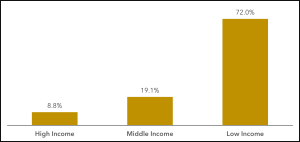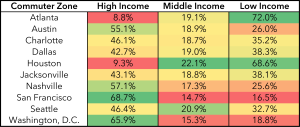In a recent post, we explored a national dataset published by Harvard University and the U.S. Census Bureau on young adult migration patterns across the country. The original dataset and study can be accessed at migrationpatterns.org.
This post drills down on one aspect of the referenced snapshot. Our last post compared Atlanta’s young adult migration from a race/ethnicity angle. Today’s post conducts a similar analysis, but this time we consider parental income (across all race/ethnicity categories). The dataset separates parental income into quintiles, which are grouped and separated in the visualizations below. The first chart shows all young adult net migration to the Atlanta commuter zone, broken down by parental income quintile. For summary purposes, the “High Income” category below is comprised of Quintiles 5 & 4, the “Middle Income” category is comprised of Quintile 3, and the “Low Income” category is comprised of Quintiles 2 & 1.
Figure 1: Atlanta young adult net migration by parental income level
According to this dataset, Atlanta’s young adult net migration has been dominated by the low income category, accounting for nearly 3 in 4 young adults migrating to the area. To put these numbers in context, we compare these percentages to the same peer cities from our last analysis.
For the comparison table below, we consider percentages for only those peer cities who experienced positive net migration in all three income categories to keep the analysis mathematically simple. The following table of percentages have been formatted with a green-yellow-red color ramp to indicate relative magnitude within a single column among each income category.
Figure 2: Peer city comparison of young adult net migration by parental income
Atlanta’s commuter zone has seen, respectively, the lowest and highest percentage of high- and low-income young adult net migration of any of the commuter zones in the above list. Only the Houston commuter zone comes close to matching this imbalance. In most cases, the number of high-income young adults migrating to the selected commuter zones (as a percentage) range from 5 to 8 times as many as those migrating to the Atlanta commuter zone. Further, the percent of low-income young adults migrating to Atlanta is two or three times that of other commuter zones listed (not including Houston).
What does all this mean? Better economic prospects are a powerful incentive which draw young adults of all income levels from one area to another. But clearly, there is a quantitative difference in the parental income level of young adults attracted to the Atlanta area as compared to other areas around the Sunbelt and even further away. Whether better job prospects, lower-cost housing, or access to higher education, the Atlanta area continues to prove itself as a powerful magnet and a “land of opportunity” for low-income young adults in the recent past.



